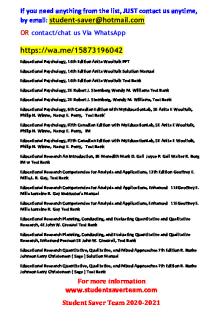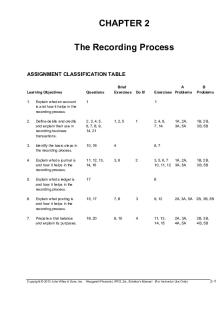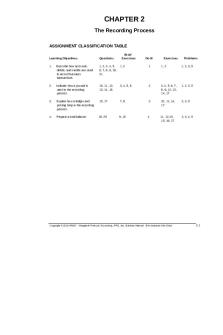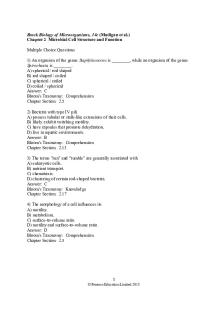Ch02 Methods of educational psychology PDF

| Title | Ch02 Methods of educational psychology |
|---|---|
| Author | Wesley Jordan |
| Course | Educational Neuropsychology |
| Institution | University of Washington |
| Pages | 15 |
| File Size | 138.4 KB |
| File Type | |
| Total Downloads | 76 |
| Total Views | 197 |
Summary
CH02...
Description
METHODS OF EDUCATIONAL PSYCHOLOGY
Introspection method This is the oldest known method for the study of behavior. In the early days of the evolution of Psychology, behavior was studied only through a kind of self-examination of inner observation called introspection. The word 'introspection' is made up of two Latin words, intra meaning "within" or "inward", and spire, meaning to "look", Hence, introspection means looking within or looking inward. In introspection then, one is required to get inside one's own mind. It is a sort of self-observation in which one perceives. Analyses and reports one's own feelings and, in fact, everything that takes place in one's mind during the course of a mental act. For example, when in a state of anxiety, fear or anger. one may be asked to determine by one's own observation what one sensed, thought or felt at the time of experiencing that emotion. Merits Introspection- the observation and reporting of one's own mental processes-is considered important on account of its unique nature. It is a simple and readily available method. One's mental processes are always present and can be introspected at any time. Introspection is, therefore, able to give us a direct and immediate insight into one's own mental processes without involving any extra expenditure of material or apparatus. Moreover, introspection provides adequate knowledge of the inner or covert experiences and thus the inner behavior of an individual in the form of thought or feeling can be revealed through introspection.
Drawbacks and Limitations Introspection as a method of studying behavior, however, suffers from some serious drawbacks and limitations: In introspection one needs to observe or examine one's mental processes carefully in the form of thoughts, feelings and sensations. The state of one's mental processes is continuously changing. Therefore, when one concentrates on introspecting a particular phase of one's mental activity that phase passes off. For example, when one gets angry at something and afterwards sits down to introspect calmly or to self -examine the state of anger is sure to have passed off and so what one tries to observe is not what is happening at that time with oneself but what had happened some time before. Introspection as a method of serious study lacks in reliability, validity and objectivity for the
following reasons: (a) The results lack reliable communicability and repeatability because any one investigator can never be sure that what he feels or senses is the same as is experienced by other investigators. If we invite introspection reports on the nature of the sensation of green for example, these reports are bound to differ. Some will insist that green is a unitary sensation, whereas others may say that green is a mixed sensation involving yellow and blue. We have no means for the objective observation of the introspection phenomenon. Moreover, in introspection one studies one's own behavior or mental process. It is not possible to verify self-observation as one's own mind cannot be studied by others in introspection. (b) It is next to impossible to acquire validity and exactness in self observation or examination of one's own mental process. The mind in perceiving its own functions tries to divide itself into two halves- the subject and the object. The object of observation and the instrument of observation are of course one and the same. This automatically affects the validity and exactness of the observation process and the perceived results. A man who is angry or afraid cannot observe exactly what is going on in his mind and remain unchanged in his emotional state of anger or fear. The consciousness on his part is sure to affect his mental or emotional state which is the object of observation. The scope of introspection as a method of studying behavior is rather limited. It can only be applied satisfactorily in the case of adult normal human beings. The behavior of children, abnormal human beings, animals etc., cannot be studied by this method.
Conclusion Thus, if we try to evaluate the introspection method we find that it is based on self-speculation, lacks reliable communicability, replicability and reasonable exactness or precision. It is neither sufficiently scientific practicable nor simple enough to handle. It cannot therefore be taken as an adequate or sufficient single method for psychological studies. The conclusions arrived at by this method need to be supported by specific scientific findings through some other objective and reliable method.
Observation method Observation as a method of studying behavior consists of the perception of an individual's behavior under natural conditions other individuals and the interpretation and analysis of this perceived behavior by them. It is thus essentially a way of 'perceiving the behavior as it is. By
this method we can infer the mental processes of others through observation of their external behavior. In fact it is an indirect approach to the study of the mental process. If some one frowns, howls, grinds his teeth, closes his fists, by observing the external signs of his behavior we can say that he is angry. But to study this behavior concerning anger in natural conditions, one has to wait for the event to occur. Similarly, to study the behavior of students in a crowd or during a strike, and the behavior of a delinquent or problem child, the psychologist has to wait till the particular behavior occurs and then use all his resources to observe record, analyze and interpret the behavior from what he has perceived under natural conditions. Merits The observation method occupies a prominent place in the study of human behavior. It is natural, flexible and economical. Its results are reliable and can be verified. The natural observation method is particularly suitable for studying the developmental characteristics of individual children's habits, interests and other personality traits. For example, the effects of the absence of one or both parents on a child s development can be determined properly through observation of his development. Similarly, a clinical psychologist may be able to collect the required data about the abnormal behavior of an individual by observing him under natural conditions of his day to day life. Drawbacks and Limitations The observation method cannot be termed as sufficiently objective, reliable and valid for the following reasons: It can prove useful only for collecting data on the observable behavior of an individual. It is impossible, to observe what is happening in the mind of others, and so reasoning can only be through external behavior. It is possible that a person may be expert at hiding his feelings and emotions and disguising his evil nature under the cover of artificial sobriety. In such cases the method of observation fails to judge the true nature of the individual concerned. Subjectivity factors on the part of the investigator as well as in the process of observation also affect the results of observation. There may be distortions of observable factors depending upon the observer's degree of care in observation. His interests, values, and prejudices may also distort the contents and results of the observation. He may lay extra emphasis on one part of one's behavior and may altogether neglect some other very important aspect. The interpretations of the recorded events may also be similarly colored. One may read one's own thoughts, feelings and tendencies into others' minds. The lacunae resulting from such subjectivity may, however, be corrected to a certain extent by having as many observers as possible for observing the same
phenomenon and employing scientific instruments such as a tape recorder, or a video camera etc., for recording the events. Another serious limitation of the observation method is that the behavior observed is dependent on the time and place and on the individual or group of people involved. It lacks replicability as each natural situation can occur only once. Another important limitation of the observation method lies in its inability to establish a proper cause and effect relationship. If two phenomena, say poverty and delinquent behavior, invariably occur together, it cannot be established that poverty is the sufficient and necessary cause of delinquent behavior or vice versa.
Experimental method The experimental method is considered the most scientific and objective method of studying behavior. It lays emphasis on performing experiments. The word 'experiment' comes from a Latin word experimental meaning 'a trial' or 'test'. Therefore, in experimentation we try or put to the test the material or phenomenon whose characteristics or consequences which we wish to ascertain. In the sciences, while conducting such experiments in the laboratory or outside in a natural environment we may want to learn the effect of friction on motion, the effect of sunlight on growth of plants, etc. In educational psychology also, we perform such experiments in the psychological laboratory, class-rooms or outside the classrooms in physical or social settings to study the cause and effect relationship regarding the nature of human behavior, i.e. the effect of anxiety, drugs or stresses on human behavior, the effect of intelligence or participation in cocurricular activities, on the academic performance of students, etc. In performing all such experiments we try to establish certain cause and effect relationships through objective observations of the actions performed and the subsequent changes produced under pre-arranged or rigidly controlled conditions. From these observations certain conclusions are drawn and theories or principles are formulated. The essential features of the experimental method are: Experiments performed in this method essentially require two persons, the experimenter and the subject or the person whose behavior is to be observed. These experiments are always conducted on living organisms in contrast to experiments in the physical sciences which are generally conducted on inorganic or dead subjects. The key factor in this method is the control of the conditions or variables. By this control we can eliminate irrelevant conditions or variables and isolate the relevant ones. We thus become able to observe the causal relationship between two phenomena, keeping all other conditions al most
constant. For example, if we try to study the effect of intelligence on academic achievement by the experimental method, we will need to determine the causative relation between the two phenomena (variables)-intelligence, and academic achievement. One of these variables, the effect of which we want to study, will be called the independent variable and the other the dependent variable. Thus the independent variable stands for the cause, and the dependent variable is the effect of that cause. Other conditions like study habits, sex, socio-economic conditions, parental education home environment health, past learning, memory, etc., which exercise a good impact upon one's achievement. As already emphasized in the experimental method experiments can be performed in the psychological laboratory or in the class rooms or outside the class-rooms under rigidly controlled conditions. Let us discuss how these experiments arc performed.
Experiments in the Laboratory Set-up Just like other physical or natural sciences, experiments can be performed In Psychology or Educational Psychology for studying the behavior in the actual laboratory set-up. Thorndike's experiments on cats, Pavlov's experiments on dogs, Skinner’s experiments on rats and pigeons and their experiments to study the behavior related to learning. transfer of learning, memory, attention, perception etc., arc all examples of 511 h laboratory experiments.
Experiments outside the Laboratory Set-up In Educational Psychology experiments can also be conducted without involving the usual psychological laboratory set up. However, for such studies, there is need of some special experimental designs for controlling the variables and measuring their effects. A few of such designs are: 1. The control test or single-group design. In these design it is not necessary to have two different individuals or group if subjects for the experiment. Here a single individual group or individual can work as the subject for the experiment. The subject whether an individual or a group of individuals, is first objectively observed under normal condition and then under different sets of changed conditions. As another illustration we may conduct an experiment to ascertain whether a group of students can do better in an intelligence test under the influence of a specific drug like Benzedrine sulphate or caffeine. For this investigation, we will take only one group of some students, preferably of the same age, sex and state of health. The procedure of the experiment will comprise the following steps:
(a) These students can be given sugar capsules after which they can be put through some intelligence test. This will provide the initial testing under normal conditions. (b) Some time later, they can be given drug capsules and tested on the same intelligence test. This will make a test under changed conditions. (c) The l.Q. scores under these two situations are noted down and the difference is calculated. 1f any significant difference is found, it will be attributed to the influence of the drug. 2. Control-group design. The control test or the single group design method has a serious drawback known as the positive practice effect. If an individual is subjected to a certain kind of fear stimulus, it will surely affect the responses on his further exposure to fear stimuli. If a group is subjected to a certain drug, then it will automatically carry its effect or influence at the time of the introduction of some other drugs at the later stage. Control group designs help in minimizing such a practice effect. In the control group design two separate groups, known as the experimental Groups, and the control group, participate in the experiment. They are equated or matched on various traits like age, sex, intelligence and other personality characteristics. There is a one-toone correspondence in the two equated groups. Now the control group is given sugar capsules and tested on some intelligence test. At the same time, the experimental group is given the drug capsule and tested on the same intelligence test. The differences in the intelligence scores of the groups are then calculated. In case some significant differences are found, they are attributed to the effect of the drug.
3. Multiple-group design. Sometimes, we have to experiment with more than two groups for arriving at the appropriate conclusion. For example, if we want to study the effect of knowledge of English on the speed with which people subsequently learn French, we decide to teach English to a group of students and then see whether they learn French more easily. But more easily than whom? Certainly we will need another group, or groups for comparison. Group A, consisting of students who have learnt the English language is called the experimental group. Group B may function as a control group for comparison, since it did not learn English earlier. If group A learns French faster than Group B can we attribute the difference in speed to the earlier study of English? Certainly not. It may be that practice on account of learning any subject or language may have the same positive transfer effect. To rule out these possibilities it is essential to add some more control groups like C and D. Now if group A demonstrates a clear superiority over the other three groups, then and only then may we infer that learning English facilitates learning
French. For illustration, the working of a multiple group design for data collection in the present case may be tabulated as shown. Group Subject for rest held in the month of August Test held in the month of February A B C D English No rest Any subject (say Mathematics) Russian French French French French 4. Designs involving rotation. This experiment involves presenting two or more stimulating situations to the experimental subjects in as many sequences as necessary to control the serial effects of fatigue or practice. For example, if we want to determine the relative influence of two specified conditions A and B (say praise and blame) on a group of subjects, we will not measure all the subjects under condition A and then under condition B. Condition A might cause fatigue or so train the subjects that the measures under condition B would not be independent of the fatigue or training effects. Here two alternatives can be adopted: (a)We may obtain half the measures for condition A, all the measures for condition B, and then the other half of the measures for condition A. This technique is sometimes called the A B B A order. (b) Another alternative is to separate the subjects into two equated groups, one of which receives treatment A and then B, whereas the other group receives treatment B and then A. Both sets of A results and both sets of B results may then be combined and the difference between them calculated. Limitations of the Experimental Method The Experimental method advocates the study of behavior under completely controlled rigid conditions. These conditions demand the creation of artificial situations or environment and the behavior studied under these conditions may be or is usually different from the spontaneous or natural behavior. Therefore, the experimental method fails to study behavior in natural conditions as may be possible through natural observation. The second limitation or difficulty lies 10 exercising actual control or handling of the independent variable and the intervening variables. It is very difficult to know and control all of the intervening variables. Similarly we cannot always control the independent variable. Therefore it is not always possible to create the desired conditions in the laboratory and
consequently, in the absence of these controlled conditions the success of this method becomes quite uncertain. 3- In the experimental method we often make use of animals or birds as subjects for experimentation. It is also debatable whether experimental results obtained from such sources are applicable to human beings at all. The scope of the experimental method is limited. All problems of psychology cannot by studied by this method as we cannot perform experiments for all the problems that may come up in the diverse subject matter of psychology. The dynamic nature and unpredictability of human behavior does not always allow the independent variable to lead to change in the dependent variable. Human behavior is not a mechanical behavior. The anger or fear producing stimuli or variables mayor may not yield the required responses as desired under experiment and hence it is not possible to get uniform responses or changes 1n the dependent variables on account of the concomitant changes in the independent variable. The experimental method is a costly and time consuming method. Moreover, the conduct of experiments under this method requires specialized knowledge and skills. In the absence of such specialized abilities, it is not possible to use this method. Differential method The differential method is based on individual differences. Therefore, all the measures applied to the calculation of individual differences are included in this method- The differential method is also named as the normative survey method or the field survey method as the investigator has to go to the field to make his investigations. It is sometimes called the statistical method for the reason that statistical techniques become the major devices for the study of the individual differences. Now, the question that arises is, how do differential methods differ from experimental methods? It may be felt that the difference between the experimental and differential methods is only arbitrary and artificial, since the procedure of finding the effects on dependent variables by the application of the independent variables is the same. This however is not true as T.G. Andrews (1958) com...
Similar Free PDFs

Educational Psychology
- 718 Pages

Educational Psychology 14
- 57 Pages

Educational Psychology 5th Edition
- 699 Pages

Educational Psychology, 14th Edition
- 170 Pages

Sampling Methods in Psychology
- 1 Pages

Ch02
- 66 Pages

Ch02
- 60 Pages

Ch02
- 18 Pages
Popular Institutions
- Tinajero National High School - Annex
- Politeknik Caltex Riau
- Yokohama City University
- SGT University
- University of Al-Qadisiyah
- Divine Word College of Vigan
- Techniek College Rotterdam
- Universidade de Santiago
- Universiti Teknologi MARA Cawangan Johor Kampus Pasir Gudang
- Poltekkes Kemenkes Yogyakarta
- Baguio City National High School
- Colegio san marcos
- preparatoria uno
- Centro de Bachillerato Tecnológico Industrial y de Servicios No. 107
- Dalian Maritime University
- Quang Trung Secondary School
- Colegio Tecnológico en Informática
- Corporación Regional de Educación Superior
- Grupo CEDVA
- Dar Al Uloom University
- Centro de Estudios Preuniversitarios de la Universidad Nacional de Ingeniería
- 上智大学
- Aakash International School, Nuna Majara
- San Felipe Neri Catholic School
- Kang Chiao International School - New Taipei City
- Misamis Occidental National High School
- Institución Educativa Escuela Normal Juan Ladrilleros
- Kolehiyo ng Pantukan
- Batanes State College
- Instituto Continental
- Sekolah Menengah Kejuruan Kesehatan Kaltara (Tarakan)
- Colegio de La Inmaculada Concepcion - Cebu







